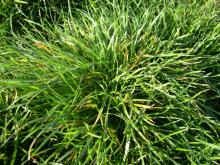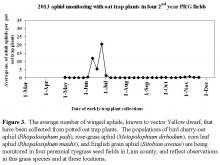Cause Barley yellow dwarf virus (BYDV) infects many cultivated and wild grasses, including tall fescue, Chewing's fescue, ryegrass, orchardgrass, and bluegrass. Many grassy species in non-managed grasslands present in the Pacific Northwest are susceptible to BYDV, including: Achnatherum lettermanii, A. occidentale, A. thurberianum, Alopecurus pratensis, Bromus inermis, Danthonia intermedia, Elymus elymoides, Poa bulbosa, P. fendleriana, P. secunda, Sporobolus airoides, and S. cryptandrus. A group of virus strains can incite yellow dwarf and cause worldwide disease problems on barley, oats, and wheat. Some hosts may not show visible symptoms of infection, as is common for corn in the Pacific Northwest. BYDV is transmitted by several species of aphid, including the bird cherry-oat aphid (Rhopalosiphum padi), rose-grass aphid (Metopolophium dirhodum), English grain aphid (Sitobion avenae), corn leaf aphid (Rhopalosiphum maidis), and green bug aphid (Schizaphis graminum). Virus strains transmitted primarily by Rhopalosiphum padi are now called cereal yellow dwarf virus (CYDV)-RPV, while those transmitted by Sitobion avenae are called BYDV-MAV. Virus strains transmitted by both aphid species are called BYDV-PAV. Metopolophium dirhodum is reported to transmit BYDV-PAV strains and possibly CYDV-RPV, while Rhopalosiphum maidis is reported to transmit BYDV-MAV and an additional strain, BYDV-RMV. Several strains of virus associated with yellow dwarf symptoms have been detected in perennial ryegrass (PRG) fields in the Willamette Valley: BYDV-PAV, BYDV-MAV, and CYDV-RPV. Studies during low aphid population years (2011-2012) in the Willamette Valley showed most PRG plants from first year fields tested positive for BYDV at low levels with only a single virus strain being found in individual plants. As aphid populations rebounded to normal-high levels the following season, the majority of plants tested positive for at least one strain of BYDV and multiple virus strains were found in approximately 50% of PRG plants tested from a plot in a commercial planting. Studies in cereals have shown that when BYDV-PAV and CYDV-RPV occur to together in a cereal plant, more severe symptoms develop, than when plants are infected with either virus strain alone.
Disease is more severe in cool, moist weather as these conditions favor aphid populations, which is usually spring or fall in the Willamette Valley. In the cereals, symptoms develop 2 to 4 weeks after infection when temperature is 68°F to 77°F and there is ample light. No symptoms develop in barley when temperature is greater than 86°F and this probably occurs in many grass species. Symptoms are not expected to develop on grass seed crops during the winter months because low temperature and light conditions inhibit symptom development. Plants become systemically infected, therefore, once perennial grass plants are infected, symptoms can reappear during subsequent growing seasons.
Damage is not always severe; it is influenced by the growth stage at infection; more severe symptoms occur when plants are infected as seedlings. Virulence of the viral strain and dosage (aphid levels), amount of primary and secondary spread, and susceptibility of the variety/grass species all affect the level of damage that occurs on a grass seed crop. Research in the UK shows that sometimes ryegrass is asymptomatic but that a reduction in perennial ryegrass height and sward growth can still be detected when plants show little foliar symptomology. While some ryegrass varieties may exhibit a decrease in leaf production, others may have a marked increase in foliage. Infection of ryegrass by BYDV can increase the proportion of vegetative to fertile tillers, and the pattern of seasonal productivity may change. Root development of ryegrass is negatively affected by BYDV and even varieties that gave increased shoot growth exhibited reduced root growth. Research in cereals has shown that hosts may be more susceptible to root rots, including Take-all, once infected by BYDV. Whether variation exists among varieties grown in western Oregon grass seed fields is unknown and little is known about the impact of barley yellow dwarf on grass seed crops.
Symptoms Symptoms can be variable and may be confused with nutrient deficiencies or stress; the presence of BYDV-PAV, BYDV-MAV, and CYDV-RPV can be confirmed with serological testing done by plant clinics. A common symptom is yellowish or reddish leaf tips. Often the leaf tissue next to the midribs stays greener than the rest of the leaf. The youngest leaves may have normal color. Affected leaves can have yellow blotches, which may become reddish to purplish. Discolored leaves may prematurely die-back during hot, dry weather. Discolored leaves may be more sensitive to cold injury; affected leaf tips of serologically-positive plants were observed to turn necrotic after below-freezing temperatures during the spring of 2013. Phloem tissue may be darkened. Root systems are often underdeveloped and plants may be more susceptible to soilborne pathogens or drought-stress. Plants affected as seedlings may be stunted and not head. In some grass species, seed yield is decreased in the absence of severe stunting. During many seasons, perennial ryegrass fields in the Willamette Valley have been found to contain infected grass plants; circular groups of affected plants can often be seen during early spring (Feb-April). Plants appear stunted and yellowish in color and will often develop purplish-red leaf tips before harvest and on the fall-regrowth. Stand die-out may occur during adverse conditions, particularly after the second year of PRG seed harvest, with dead or unthrifty plants becoming apparent during regrowth after the summer dry period and subsequent winter weather.
Cultural control
- Sow new plantings in late fall or early spring so seedling stage is before or after peak aphid flight.
- In affected plantings, reduce stress on plants by providing balanced fertility. Consult OSU Extension EM 9086: Nutrient Management Guide for Perennial Ryegrass Grown for Seed (Western Oregon).
Chemical control BYDV cannot be controlled directly in grass plants but growers can control indirectly by slowing or stopping spread. Apply granular systemic insecticides in-furrow at planting to reduce aphid numbers. Foliar sprays prior to peak flight in the spring and fall can also reduce aphid numbers. Research by OSU has shown yield improvements during the second seed harvest in limited studies; however, yields may not be boosted under lower aphid populations. (For materials, rates, and procedures, consult the PNW Insect Management Handbook.)
References Catherall, P.I., and Parry, A.L. 1987. Effects of barley yellow dwarf virus on some varieties of Italian, hybrid and perennial ryegrasses and their implication for grass breeders. Plant Pathology 36:148-153.
Ingwell, L.L., and Bosque-Perez, N.A. 2015. New experimental hosts of barley yellow dwarf virus among wild grasses, with implications for grassland habitats. Plant Pathology 64:1300-1307.







